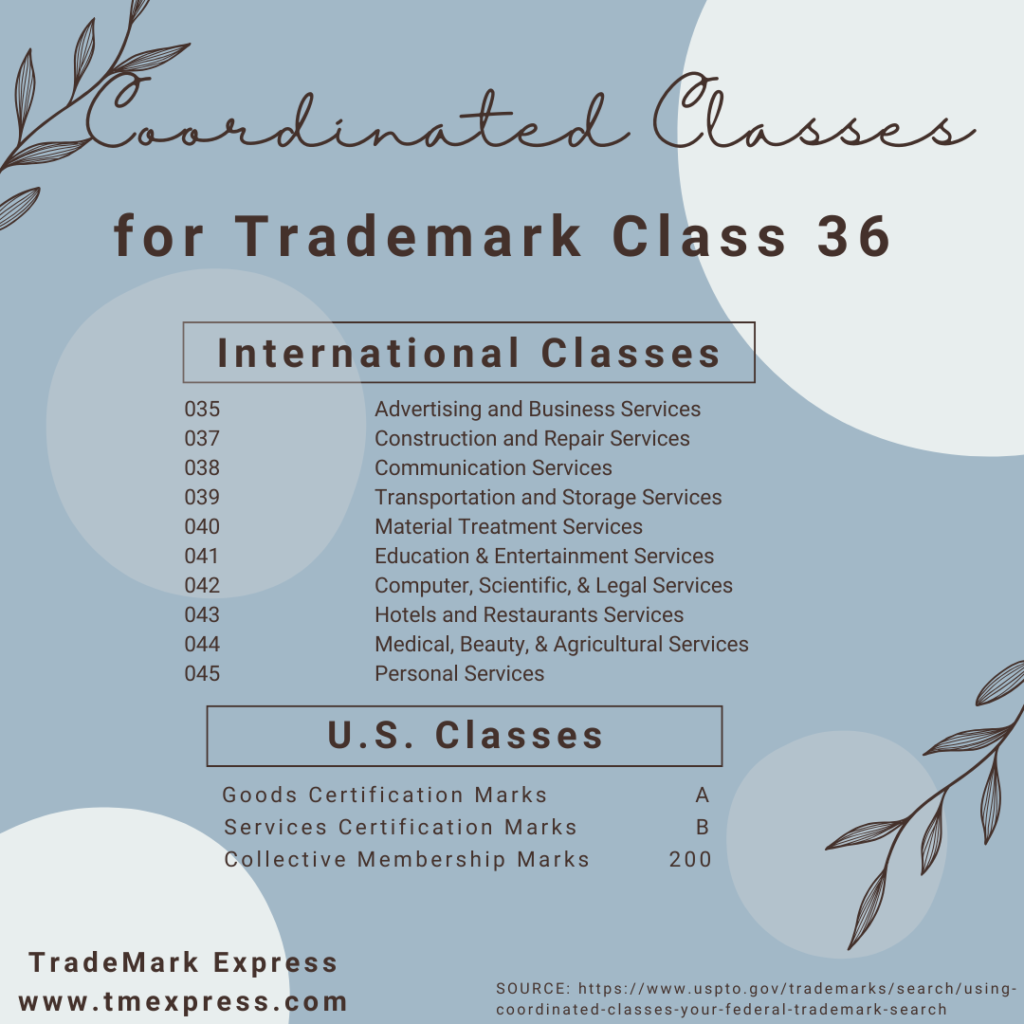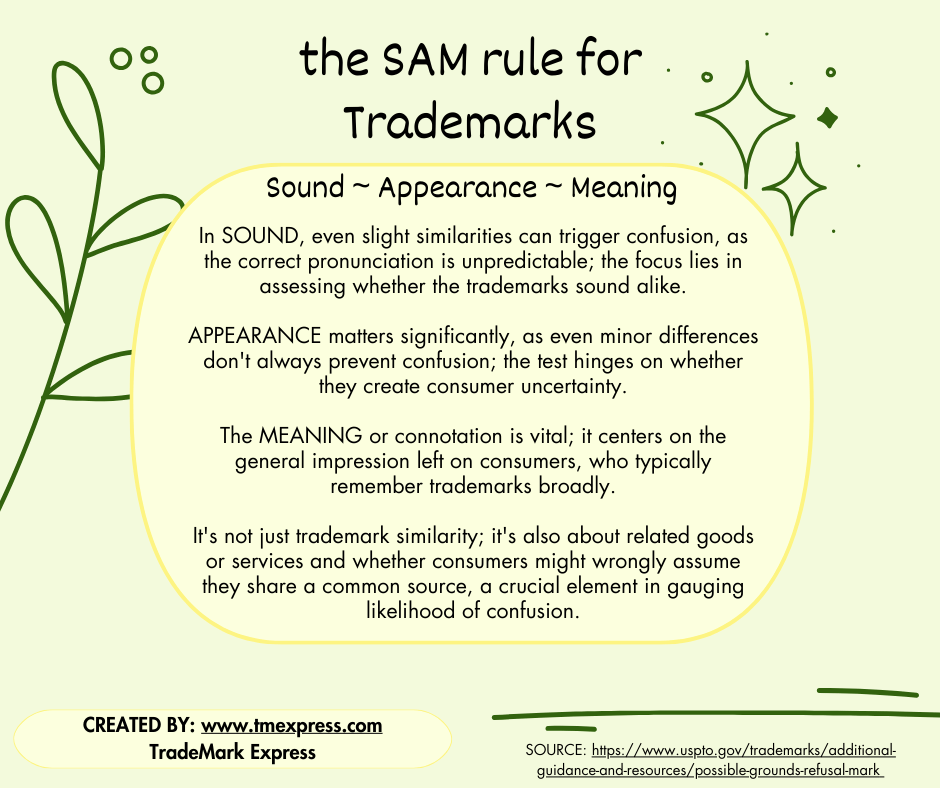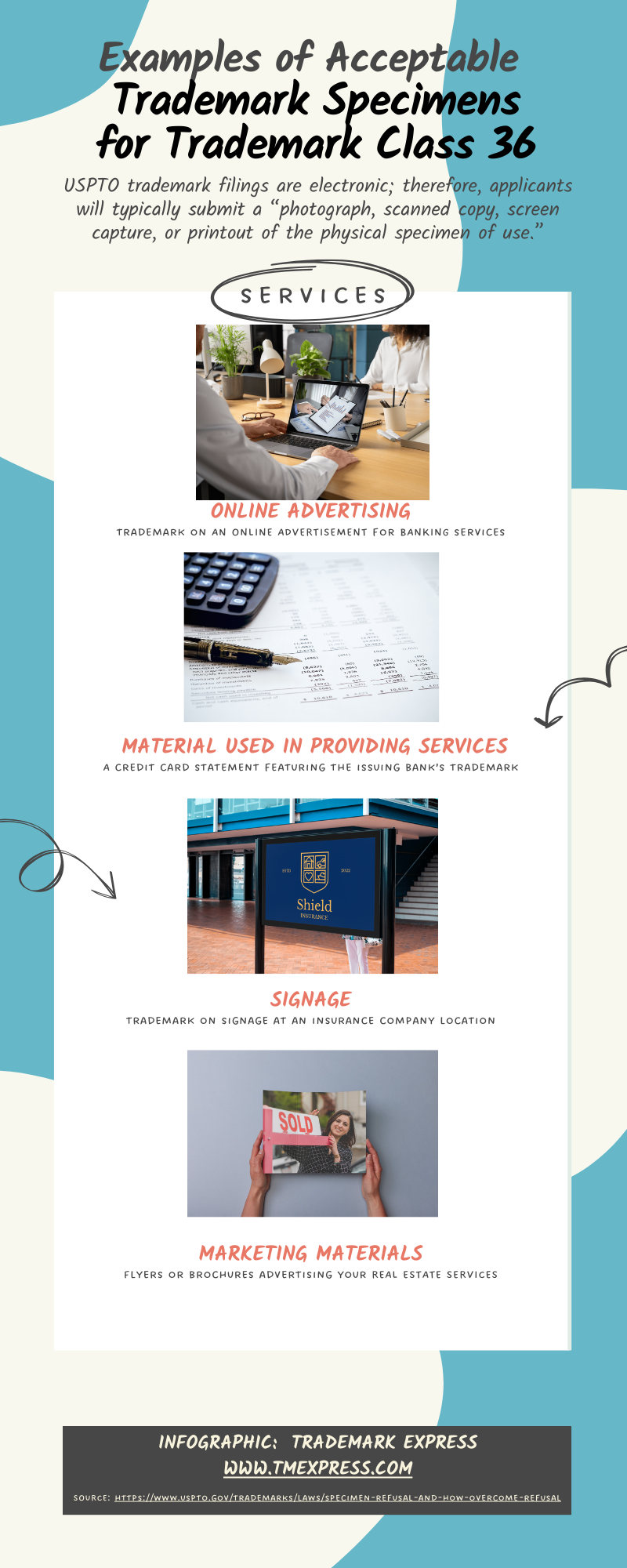Trademark Class 36: Financial, Insurance, & Real Estate
Trademark Class 36 plays a vital role in trademark registration for businesses offering financial, insurance, and real estate services. Understanding what trademark class 36 covers ensures that your trademark is filed correctly and protects your brand in these industries. Let’s explore everything you need to know about this class and how it applies to your business.
The number of trademark classes you select also affects the cost of your application. The USPTO charges fees on a per-class basis, currently ranging from $250 to $350. Starting January 18, 2025, these fees will be standardized at $350 per class, as the TEAS Plus and Standard designations will no longer apply. Selecting the correct class is essential to protect your brand while avoiding unnecessary expenses.
What Is Trademark Class 36?
Trademark Class 36 focuses on services related to finance, insurance, and real estate. According to the Nice Classification: “Class 36 is for financial, monetary and banking services; insurance services; real estate services.”

In simpler terms, Class 36 covers a broad range of services including banking, financial valuation, real estate management, and insurance underwriting.
Common Services in Trademark Class 36
Trademark Class 36 includes various types of services:

- Financial Transactions: Services like exchanging money, electronic funds transfers, and processing credit or debit card payments.
- Financial Valuation: Appraisals for jewelry, art, real estate, or repair costs.
- Insurance Services: This includes underwriting, actuarial analysis, and insurance brokerage.
- Real Estate Activities: Services such as real estate agency work, rental collection, and property management.
- Specialized Financial Services: Includes safe deposit services, crowdfunding platforms, and financial sponsorship.
What Trademark Class 36 Does Not Cover
Not all financial-adjacent services fall into Class 36. Services often confused with this class include:
- Business Financial Services: Tax preparation, bookkeeping, and business auditing fall under Trademark Class 35.
- Logistical Financial Services: Cash replenishment for ATMs or transport brokerage is classified under Trademark Class 39.
- Specialized Appraisal Services: Quality evaluations of wool or standing timber are included in Trademark Class 42.
Coordinated Classes for Class 36
Trademark services often overlap, especially for businesses that span multiple industries. Coordinated classes help identify related services or goods that may also need trademark protection. For Trademark Class 36, the coordinated classes include:

- Class 35: Advertising and business services.
- Class 37: Construction and repair services.
- Class 38: Communication services.
- Class 39: Transportation and storage services.
- Class 40: Material treatment services.
- Class 41: Education and entertainment services.
- Class 42: Computer, scientific, and legal services.
- Class 43: Hotel and restaurant services.
- Class 44: Medical, beauty, and agricultural services.
- Class 45: Personal services.
- Class A: Goods certification marks.
- Class B: Services certification marks.
- Class 200: Collective membership marks.
For instance, a company providing real estate financing might consider Class 36 for financial services and Trademark Class 35 for related advertising services. A coordinated class strategy ensures comprehensive trademark protection.
Importance of a Trademark Search for Class 36
Trademark searches are essential for businesses filing under Class 36, where industries like finance, insurance, and real estate face high stakes and potential for legal disputes. Conducting a trademark search ensures your chosen mark is unique and avoids conflicts with existing trademarks.
The services in Class 36 often involve trust and reputation. For instance, imagine a financial advisory firm called “Gold Shield Financial” discovers after registration that another firm, “Golden Shield Advisory,” is offering similar services. The similarity could confuse clients, harm your business reputation, and lead to costly legal battles. A thorough search can prevent such scenarios.

Types of Searches and Their Importance
Federal Trademark Search
This search examines the USPTO database for registered and pending trademarks. It ensures your mark doesn’t conflict with federally protected trademarks. For Class 36, a federal search might identify a registered trademark for a financial management company with a similar name
State Trademark Search
Many businesses only register trademarks at the state level. A state search uncovers these registrations. For instance, a small, state-registered insurance brokerage could have priority in its region despite lacking federal registration.
Common Law Search
This search identifies unregistered trademarks through business directories, online platforms, and industry publications. Common law rights arise from use in commerce, even without registration. For example, a local real estate company using a similar name might not show up in federal or state databases but could still pose a legal challenge.
Examining Similarities
A trademark search also considers:

- Sound: Are the marks pronounced similarly? For example, “Shield Finance” and “Sheald Financial” may sound alike.
- Appearance: Does the visual presentation of the marks create confusion?
- Meaning: Are the marks conceptually related, even if spelled differently?
Related Goods and Services
A comprehensive trademark search also evaluates whether goods or services are related, even if the trademarks themselves are not identical.
For instance, imagine a financial planning services company, “Smart Wealth Advisors,” applies for a trademark in Class 36. If the USPTO identifies a registered trademark for a financial planning software platform, “SmartWealth” in Trademark Class 42, it could create grounds for refusal.
Both serve a similar purpose—helping customers manage finances—and likely target overlapping audiences. This similarity could lead to consumer confusion about whether the two are affiliated. A thorough search ensures potential conflicts like this are identified and addressed before filing, saving time and avoiding costly issues.
Consulting professionals like TradeMark Express ensures every aspect of your search is thorough.
Acceptable Specimens for Class 36
The USPTO requires applicants to submit a specimen showing how the trademark is used in commerce. For services in Class 36, acceptable specimens include:

Online Advertising or Printed Matter
Example: A screenshot of a bank’s online ad for electronic funds transfer services.
Marketing Material
Example: A real estate agency’s brochure promoting rental management services.
Signage
Example: A sign at an insurance company’s office advertising underwriting services.
Material Used in Rendering Services
Example: A credit card statement featuring the issuing bank’s trademark.
Invoices
Example: A billing statement from a crowdfunding platform, displaying its trademark.
Business Cards and Letterhead
Example: A financial advisor’s business card showing their company name and logo.
Submitting the correct specimen is critical. If the specimen doesn’t clearly associate the trademark with the services, your application may face rejection or delays. Ensure the submitted materials meet USPTO requirements to avoid complications.
Conclusion
Trademark Class 36 is vital for businesses in the financial, insurance, and real estate sectors. By understanding its scope, considering coordinated classes, and conducting a thorough search, you can secure robust trademark protection.
TradeMark Express specializes in comprehensive trademark searches and application processes, ensuring your mark is protected and ready for success. Contact us today to get started on your trademark journey!

This article provides a clear and comprehensive overview of Trademark Class 36, which covers services related to finance, insurance, and real estate. It highlights the importance of correctly classifying trademarks to avoid unnecessary costs and potential legal issues. The detailed breakdown of services included in this class, along with common misconceptions, makes it a valuable resource for businesses navigating trademark registration. A thorough trademark search is emphasized as crucial to ensure brand protection and avoid conflicts with existing trademarks.